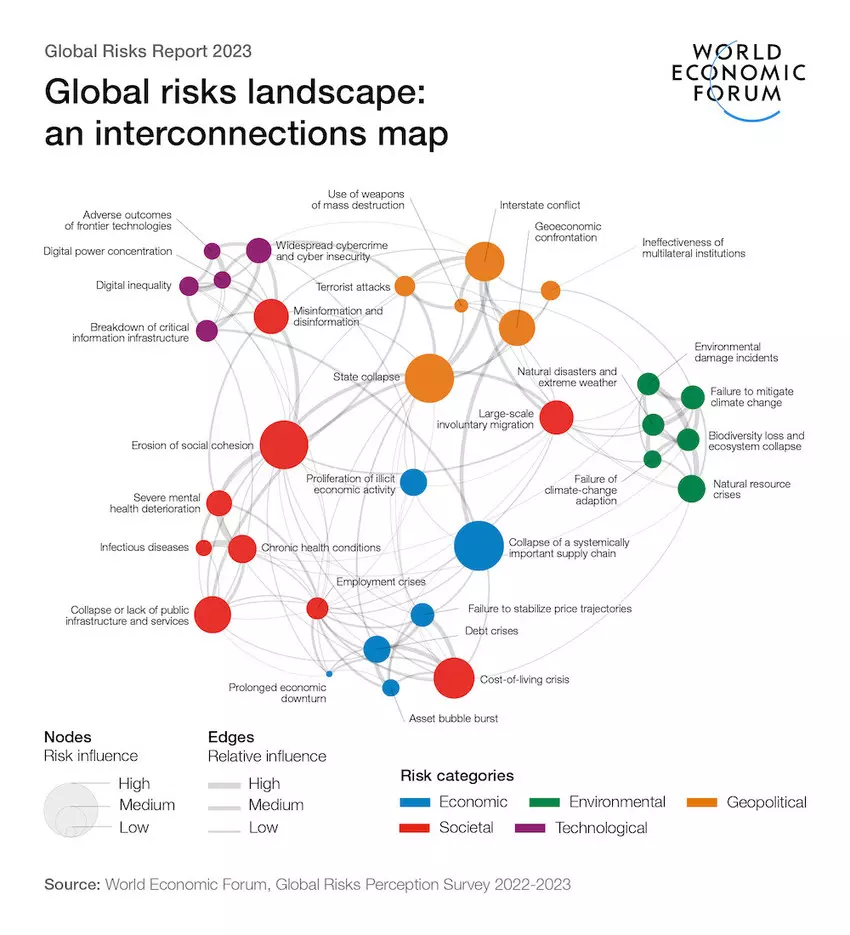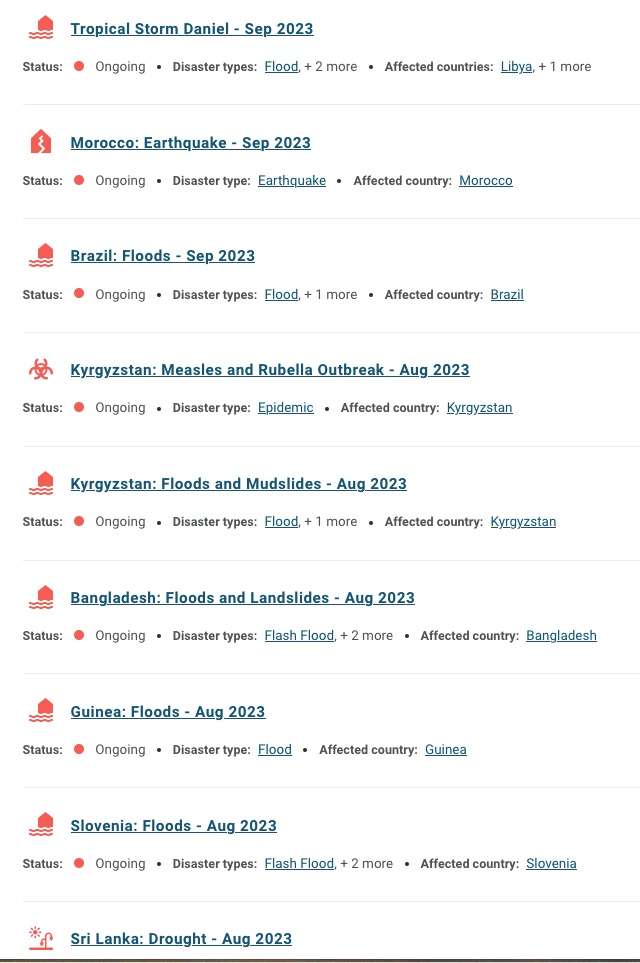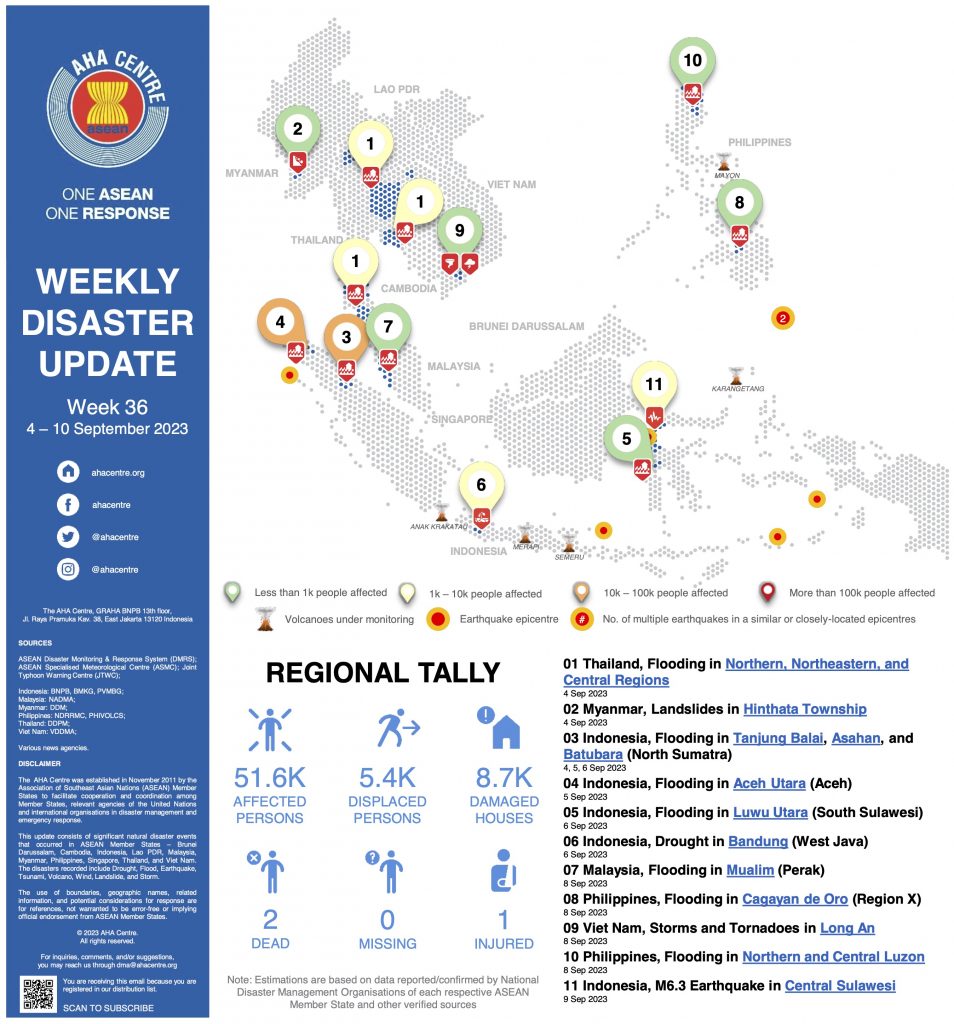The aftermath of the recent Wadi Derna flood in Libya
Language matters. If we talk only about “global warming” or “climate change”, those terms don’t convey anything like the scale of the devastation that the climate crisis is already inflicting on humankind. So let’s call it what it is: A very present climate crisis.
Figuring out how to respond to this crisis is made many times harder by the fact that it is closely entwined with crises of governance collapse at many levels around the world.
The most impactful level of entwinement has long been the global. Global discord and the often-blind selfishness of the leaders of rich countries mean that these countries still continue to pump greenhouse gases (GHGs) into the atmosphere at a rate that guarantees there is no prospect that worldwide GHG emissions—and therefore global heating—will be ended within the next 25 years.
The assessments that will be presented to next week’s meeting in New York on the UN’s Sustainable development Goals (SDG’s) are bleak, indeed.
The pace of global warming (heating) has accelerated visibly in recent years. But it’s been underway for several decades already, with effects such as the melting of ice-packs worldwide, desertification of land-masses, heating of seas and the exacerbation of hurricanes and other dire weather events becoming increasingly evident in many parts of the world.
These effects of the climate crisis have long shown themselves capable of causing or sharply exacerbating crises of governance. Some examples: the effects of Hurricane Katrina in Louisiana in 2005; the roiling effects of desertification in the Sahel region of Africa; the social/political breakdowns that followed widespread desertification in Syria.
Another entwinement: crises of governance at many levels can stymie even the most basic preparedness/resilience measures such as maintaining regular inspections of critical infrastructure or installing effective and timely warming systems.
That seems to have been the case in the horrendous recent flood disaster in Derna, in Eastern Libya. Critical dams upstream of that large city had reportedly not had any regular inspections after Libya’s national government collapsed under NATO’s military pressure there in 2011; and residents reported either zero early warning or only a smattering of unclear, conflicting messages.
Reporting from in and around that stricken city is still incomplete, but Libya’s Red Crescent Society estimates the numbers of those killed at around 10,000. Petteri Taalas, the head of the World Meteorological Organization said yesterday that many of those casualties could have been avoided if the divided country had had a functional weather service.
Another example: After last February’s devastating earthquakes in southern Turkey (and northwest Syria), it became clear that developers of many large housing blocks in the affected areas of Turkey had flouted the building codes introduced after earlier quakes in that vulnerable region, and had gotten away with because of deeply embedded corruption.
Good governance is needed both for the prevention of disasters, and for building the preparedness capacities needed to reduce their effects if (when) they should occur.
Then, there is the matter of how effectively communities can respond to disasters after they have occurred. To a large extent, this is a function of the preparedness measures outlined above. Local, national, and regional governments need to plan to respond to a broad range of disasters including those that are directly man-made, like train crashes, or wholly “natural”, such as earthquakes. But as the climate crisis worsens they will also need to be ready to respond to all the accelerating numbers of disasters that arise from the long-incubating climate crisis (which we could describe as indirectly man-made.)
Response to all these kinds of disasters is a core function of good governance. Consider the hellish state in which the 11.5 million people of Haiti have lived ever since a brief period of some governmental accountability, 1995-2004, was abruptly ended by a U.S.-backed revolt that pushed Pres. Bertrand Aristide from power. Haiti has long been extremely impoverished and is frequently buffeted by both hurricanes and earthquakes. In 2010, it was struck by a Magnitude 7.0 quake that killed some 32,000 and made hundreds of thousands homeless. The national government was incapable of any helpful response and a U.N. mission deployed there (under the guidance of UN Special Envoy Bill Clinton) was similarly ineffective—or actively dysfunctional, since its members spread cholera and some sexual abuse among the hard-pressed Haitians.
Or consider the plight of people in Morocco today, where survivors of last week’s earthquake have been crying out for help and their own government, while proving itself largely incapable of meeting their needs, has been turning down offers of help from many neighboring states.
Global and regional dimensions
The global disaster-relief website Reliefweb.int currently lists 12 significant disasters worldwide that erupted during the six weeks following August 1. (Their list notably does not include disasters in countries where international help is not needed, such as China, which has experienced serious flooding in several areas in recent weeks.)
Nearly all the 12 disasters on the Reliefweb list seem to have a close link to the climate crisis: eight are major floods, one is a drought (Sri Lanka), two are epidemics (Guatemala and Kyrgyzstan), and one is the Moroccan earthquake. The need for governments to ramp up preparedness in all its forms seems clear!
Regional and inter-governmental coordination is also increasingly necessary—especially since the effects of the climate crisis recognize no international boundaries. I’ve been stunned during the latest disasters in Morocco and Libya to hear zero reporting on any intervention or activity at all from Arab League. That regional grouping, which 40 years ago still had some ability to coordinate or even lead various forms of joint action, now seems completely AWOL. Having different Arab and other countries all send their own separate assistance missions to a stricken place like Libya may be laudable, but it is very far from optimally effective.
Other regional organizations seem much more advanced in their disaster-response planning and capabilities. The Association of South Eastern Nations, ASEAN, publishes a “Weekly Disaster Update”, which no doubt helps the member countries to plan and coordinate their responses to their region’s numerous climate-related or seismological events. (Go to the link to see the whole content of their latest update.)
How about other regional organizations? The African Union seems to have been improving its disaster-response preparations very impressively. (See, e.g., this, this, or this.) And the AU’s “Champion for Disaster Risk Management” speedily sent a message of support to the people and government of Morocco after the earthquake there, calling on all African and non-African nations to urgently send specialized assistance to that fellow African country.
The European Union has highly developed mechanisms for coordinating disaster response among the member states—but it seems mainly to focus on responses to disasters occurring within its member states.
For its part, the Organization of American States seems very poorly organized in the disaster-response coordination field.
Exploring polycrisis
The term “polycrisis” was, by all accounts, first coined in 1993 by the French philosophers Edgar Morin and Anne-Brigitte Kern. According to Vijay Prashad, Morin and Kern argued that, “there is no single vital problem, but many vital problems, and it is this complex intersolidarity of problems, antagonisms, crises, uncontrolled processes, and the general crisis of the planet that continues the number one vital problem.”
Prashad noted that the term was then used in a speech by then President of the European Commission Jean-Claude Juncker, in which he said,
This European Union has faced its worst economic, financial and social crisis since World War II… Our various challenges… have not only arrived at the same time. They also feed each other, creating a sense of doubt and uncertainty in the minds of our people.
Hence, the polycrisis that humankind now faces has not only grave social, political, and economic dimensions but a key psychosocial dimension that further inhibits our ability to address this crisis in a calm and cooperative manner.
It is true that humankind currently faces a “polycrisis” in this sense. However, I feel that many of the ways in which this term is used are actually far too complex—and this complexity is itself obfuscatory, and thus a hindrance to clear thought and action. For example, “polycrisis” was apparently the “term du jour” last January at the high-jet-fuel shindig that ruling neoliberals and their hangers-on like to stage every year in Davos, Switzerland. And the host of the gathering then put numerous multimedia explorations of the concept onto their website. Including this graphic:

There are a lot of small critiques one could raise about that diagram. (Why are the “environmental” risks all displayed so small and all placed so separate from the other forms of risks identified? Why does the diagram tell us nothing about the particular vulnerabilities in all these forms of crisis, of women, girls, and other traditionally marginalized or disenfranchised communities? Etc… )
But for me, the essential weakness of the diagram is its complexity—and the fact that within it, just about everything seems to be connected with everything else. Which means that though it has an attractive array of colors and blob-sizes, and connectors of varying widths, what it basically ends up telling is either (a) nothing, or (b) that oh boy, these crises are all so complex and so intertwined that there’s nothing we can do about them…
Hence, my strong preference for thinking about humankind’s current polycrisis primarily in terms of just the two variables of environmental crisis and the crises of governance that are now evident all around the world. Thus, if we want to figure out What Is To Be Done, let’s focus first on those two. (And let’s pay absolutely zero heed to Davos’s risk of an “Asset bubble burst”…)
For example, given the scale of the already present environmental crisis, what sense does it make to continue to be building any new private automobiles at all, whether they guzzle gasoline or are powered by (actually very heavy-to-transport) electric motors whose electricity is often still itself generated in gas-fired power plants? Wouldn’t it make more sense to invest very heavily in public forms of ground transport at all levels, from buses to local trains to high-speed intercity trains, while preserving the existing stock of private cars so that members of needy groups can use them as we all shift much faster to all the modes of public transport?
For America, this is just a thought exercise for now. Sadly. But if we want to take serious steps toward decarbonization, these are exactly the kinds of measures that we as a society will need to implement… And that, of course, is a huge governance challenge!
If we don’t take radical steps like these to decarbonize our lives, then we as Americans can absolutely know that our failure to do so is increasing both the risk and the scale of future flooding and hurricane events in vulnerable places like Libya, Brazil, Liberia, Kyrgyzstan, Bangladesh, and Guinea—as well as here at home. At one level, it really is that simple.
So yes, there are governance challenges at many levels involved. My esteemed colleague Indi Samarajiva describes what’s needed in pretty apocalyptic terms:
So if you’re seriously asking how we stop climate collapse, then… we don’t need a superhero, we need a supervillain. We need a time-travelling Super Mao that travels back in time, imposes totalitarian climate communism, and beats the shit out of anyone that complains about it. That’s simply the only way to get big changes in such a little time. You’d need climate dictatorship, not this dithering bullshit we’re doing now.
He also takes us on a deeply thought-provoking “road-trip” toward total climate collapse. It ends thus:
We’re just driving this whole civilization off a cliff and we’re going to have to limp out and walk for the rest of our lives, like my grandparents did. And that’s the best-case scenario. We should be so lucky. For many of us and all of our high ambitions, the road just ends in ruin.
All very stirring and well worth reading and thinking about… But the main thought I want to leave you with here is that addressing our planet’s climate crisis is quintessentially a political problem. It’s a problem of collective action and of governance at every level.
There are thousands of actions we need to take in our own lives, in the lives of our communities, our cities, our states, and the country as a whole. Those can each make a bit of a difference. But they will count for nothing unless we also start to plan for the preservation of human society and of our planetary environment, alongside the rest of humanity. To do that requires real, respectful cooperation across national borders with the 95% of the world’s people who happen not to be U.S. citizens. Militarism and hegemonic thinking are absolutely not the way to go. They only raise both the scale and the imminence of planetary disaster.




